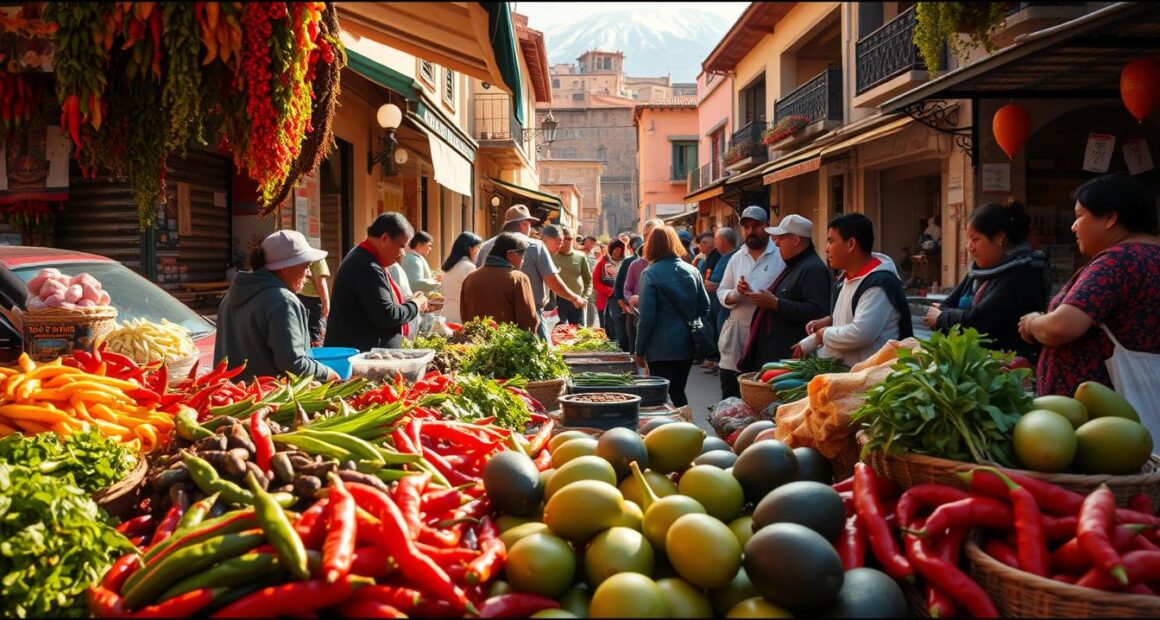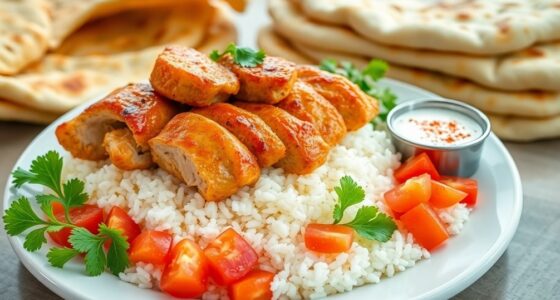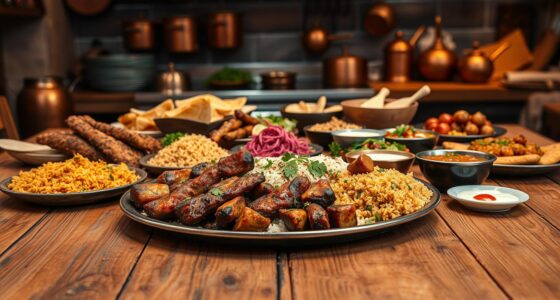Imagine standing in a bustling open-air market, the air thick with the aroma of grilled meats and zesty citrus. More than just flavors, Peruvian cuisine tells the stories of vibrant cultures intertwined through generations. As you take in the vibrant hues of fresh ingredients—red ají peppers, golden corn, and earthy potatoes—you can’t help but feel a deep connection to a land rich in culinary heritage. Your senses awaken to the diverse palette that represents not only the heart and soul of Peru but also the very essence of its people.
From the fresh coastal delicacy of ceviche to the comforting warmth of aji de gallina, each dish is a celebration of Peru’s agricultural diversity, boasting over 4,000 varieties of potatoes and a fusion of flavors influenced by indigenous history and global culinary trends. This journey through Peruvian cuisine will reveal the traditional Peruvian dishes that have captured hearts around the world. Are you ready to explore the culinary treasures that await?
Key Takeaways
- Peruvian cuisine is a blend of indigenous, Spanish, African, Chinese, and Japanese culinary traditions.
- Ceviche, recognized as the national dish, showcases Peru’s abundant seafood resources.
- Aji de gallina highlights the rich use of creamy sauces in traditional dishes.
- Peru is home to over 4,000 varieties of potatoes, a cornerstone of its agricultural diversity.
- Lima has emerged as a culinary hotspot, home to many internationally recognized restaurants.
- Street food like anticuchos reflects Peru’s vibrant and informal dining culture.
- Modern interpretations of traditional recipes are making Peruvian cuisine increasingly popular worldwide.
Introduction to Peruvian Cuisine
Peruvian cuisine has gained significant recognition on the international gastronomic scene. Its appeal lies in the rich tapestry of flavors that showcase Peruvian food culture and diverse ingredients. This vibrant cuisine benefits from the unique combination of indigenous, European, and Asian influences, resulting in dishes that are both delightful and memorable. Traditional cooking methods emphasize the use of fresh, local products sourced from Peru’s 28 individual climates, which play a vital role in shaping the flavors of its celebrated dishes.
The heart of Peruvian culinary traditions lies in native ingredients, such as potatoes that boast an astonishing 3,800 to 4,000 varieties and are the foundation of many meals. Peru is recognized as the birthplace of these tubers, with 99% of all potatoes worldwide tracing back to a subspecies originating here. The extensive cultivation of chiles, ongoing for approximately 7,000 years, adds an unmistakable kick to various recipes, showcasing over 300 different varieties grown across the country.
Peruvian gastronomy excels in its signature dishes. Ceviche, the national dish, features white sea bass marinated in zesty Peruvian limes, often served alongside sweet potatoes and cancha, toasted corn kernels. Classic dishes like Anticuchos, made with marinated cow hearts, and hearty staples such as Causa Rellena de Cangrejo exhibit the creativity inherent in Peruvian kitchens. Each meal tells a story, steeped in cultural significance, while simultaneously delighting the palate with robust flavors.
Key Ingredients in Peruvian Dishes
Peruvian cuisine boasts a rich array of ingredients that create its distinctive and diverse flavors. Understanding the key components, including common spices in Peruvian dishes and popular vegetables, enhances your culinary journey. Let’s explore what makes this cuisine so unique.
Common Spices and Seasonings
Spices form the foundation of authentic Peruvian recipes, adding depth and character. One of the most notable is ají amarillo, a vibrant yellow chili that is often called the “DNA of Peruvian cuisine.” This spice appears in numerous traditional dishes, enriching sauces and marinades. Other essential spices include cumin, garlic, and cilantro, each bringing a robust flavor that highlights local ingredients.
Another standout spice is the ají rocoto, a spicy pepper native to Peru, known for its tropical notes. These common spices in Peruvian dishes not only enhance flavor but also contribute to the overall health and vibrancy of the meals.
Popular Vegetables and Fruits
Vegetables in Peruvian cuisine are just as diverse and plentiful as the spices. Peru is home to over 3,000 varieties of potatoes, making them a staple in Andean diets. Varieties range from yellow potatoes to sweet potatoes, each adding unique textures and flavors to dishes. In addition, red onions frequently appear in culinary creations, often surpassing the use of yellow onions.
Fruits such as soursop and lucuma not only enhance the flavors of desserts and beverages but also promote a health-conscious lifestyle. The incorporation of quinoa, although less common today due to rising costs, retains its place as a nutritious component with deep historical roots in the Andes.
| Ingredient | Type | Typical Usage |
|---|---|---|
| Ají Amarillo | Spice | In sauces and marinades |
| Aji Rocoto | Spice | In various dishes for heat |
| Red Onions | Vegetable | In salads and main courses |
| Potatoes | Vegetable | As a staple in numerous dishes |
| Soursop | Fruit | In desserts and juices |
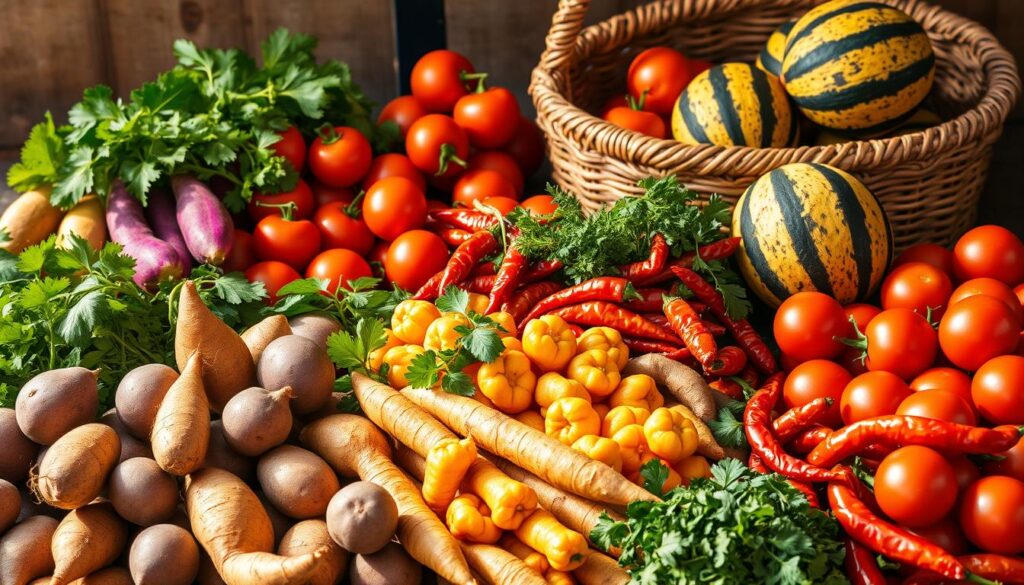
Ceviche: The Star of Peruvian Cuisine
Ceviche stands as the quintessential symbol of popular Peruvian dishes, embodying the vibrant flavors and fresh ingredients that characterize this rich culinary tradition. This delicious dish features various ceviche variations, each highlighting unique local ingredients and techniques. Its history stretches back thousands of years, reflecting Peru’s cultural tapestry.
Variations of Ceviche
When exploring ceviche, the range of flavors is astounding. Here are some notable ceviche variations:
- Tiradito: Unlike traditional ceviche, this version features fish cut into strips, dressed with a piquant marinade that enhances its boldness.
- Mixed Seafood Ceviche: This delightful variant combines octopus, shrimp, and squid, delivering a mix of textures and tastes.
- Amazonian Ceviche: Utilizing regional fish from the Amazon, such as paiche, this variation introduces earthy and exotic notes.
How to Make Classic Ceviche at Home
Are you ready to try your hand at making this iconic dish? Discover how to make ceviche with just a few key steps:
- Start with the freshest fish, like corvina or sole, ensuring high quality for the best results.
- Marinate the fish in the juice of up to 12 limes for about 5 to 15 minutes, depending on your taste preference.
- Add finely sliced red onions and diced ají chiles to infuse heat and flavor.
- Serve the ceviche cold, accompanied by sides of boiled sweet potatoes, giant kernel corn, and cancha for added texture.
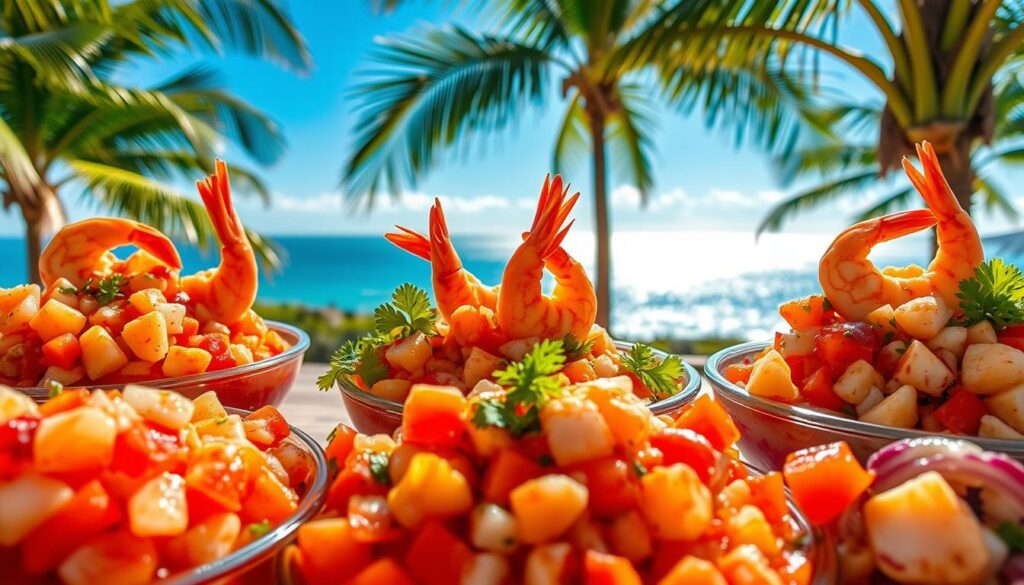
Enjoy how fresh ingredients unite to create vibrant, authentic Peruvian recipes that resonate with flavor and history. The preparation of ceviche is simple yet rewarding, resulting in a dish that showcases the essence of Peru’s culinary heritage.
Aji de Gallina: A Comforting Classic
Aji de gallina stands out as a beloved dish in the realm of traditional Peruvian dishes. This creamy chicken delicacy blends indigenous ingredients with Spanish influences, creating a rich and comforting meal that warms the soul. You may wonder about the aji de gallina ingredients that make it so unique and flavorful. Understanding how to prepare aji de gallina will help you recreate this authentic Peruvian recipe in your own kitchen.
Ingredients You’ll Need
To achieve the distinctive taste of aji de gallina, you’ll need the following ingredients:
- Shredded chicken
- Aji amarillo paste (yellow chili pepper)
- Walnuts
- Hard-boiled eggs for garnish
- Olives for garnish
- Milk
- Whole wheat bread
- Vegetable oil
- Garlic
- Onion
- Rice or boiled potatoes (for serving)
Step-by-Step Cooking Guide
Follow these steps to learn how to prepare aji de gallina and enjoy this comforting dish:
- Cook the chicken in a pot until tender, approximately 15 minutes.
- Allow the chicken to cool, then shred it into small pieces.
- In a blender, combine aji amarillo paste, walnuts, bread, and milk. Blend until smooth.
- In a pan, heat oil and sauté garlic and onion until golden.
- Add the blended aji amarillo sauce to the pan and simmer for about 5 minutes.
- Stir in the shredded chicken and cook until heated through.
- Serve over rice or with boiled potatoes. Garnish with hard-boiled eggs and olives.
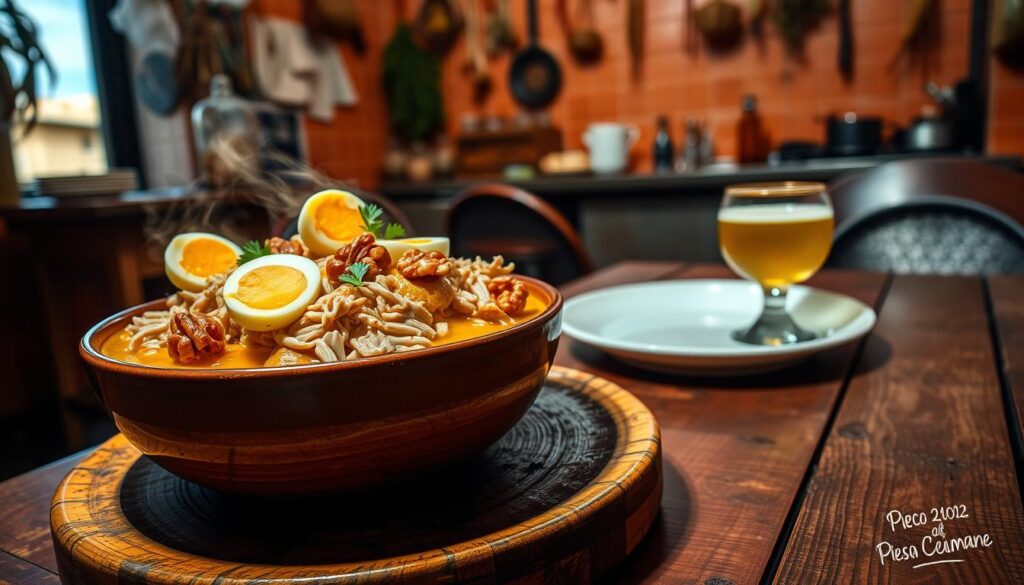
Aji de gallina provides a satisfying meal with approximately 136 calories per serving, 12 grams of protein, and a moderate fat content. As you can see, learning how to prepare aji de gallina not only introduces you to a delicious recipe but also offers a glimpse into the heart of authentic Peruvian cuisine
Lomo Saltado: A Fusion of Flavors
Lomo saltado exemplifies the incredible fusion present in Peruvian cuisine history. Originating from the chifa culinary tradition, this dish beautifully marries the techniques of Chinese stir-frying with local Peruvian ingredients. Recognized as one of Peru’s most loved dishes, lomo saltado incorporates thinly sliced beef steak, onions, tomatoes, and crispy French fries, creating a delightful flavor and texture combination that delights many palates.
History Behind Lomo Saltado
The story of lomo saltado is rooted in the history of lomo saltado itself. Chinese immigration to Peru surged between 1849 and 1874, as Chinese individuals replaced African slave laborers in various sectors. The term “saltado,” referring to stir-fry, is unique to Peru, marking a culinary distinction that did not appear in other Latin countries. The fusion was noted in a Peruvian cookbook from 1903, which included a brief mention of lomo saltado. This highlights the early integration of this dish into the broader landscape of Peruvian cuisine.
How to Serve It for Maximum Flavor
When serving lomo saltado, pack it with flavor by placing it over a bed of steaming rice and alongside crispy French fries. Garnishing with fresh cilantro and a squeeze of lime elevates its savory taste. This dish is a staple at the best Peruvian restaurants, celebrated for its satisfying balance of flavors. Whether you prepare it at home or enjoy it at a restaurant known for serving lomo saltado, the warm, inviting profiles of this dish always make it a memorable experience.
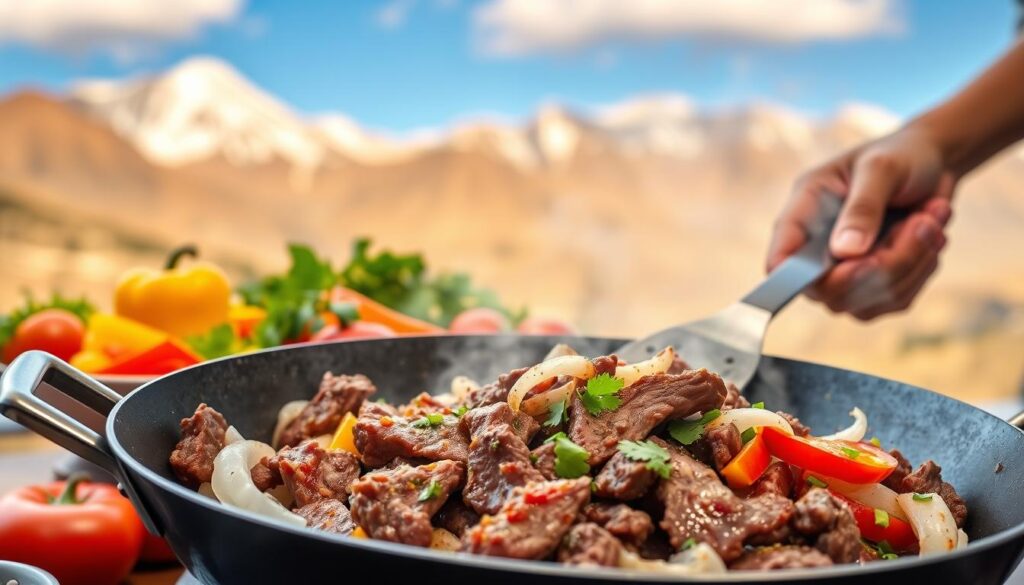
Huancaina Sauce: A Creamy Delight
Huancaina sauce, a creamy Peruvian classic, originates from the high altitudes of Huancayo. This beloved sauce features a rich blend of aji amarillo, queso fresco, and evaporated milk, making it a staple in authentic Peruvian recipes. Its versatility allows for a variety of delicious huancaina sauce pairings, enhancing everything from boiled potatoes to grilled meats and vegetables.
Perfect Pairings for Huancaina Sauce
When exploring the world of traditional Peruvian dishes, you’ll find that huancaina sauce wonderfully complements various ingredients. Here are some popular pairings:
- Boiled Potatoes: The classic foundation of this dish.
- Pasta: Adds a creamy twist to your favorite noodles.
- Grilled Vegetables: Elevates the flavors and adds a spicy kick.
- Marinated Meats: Serves as a zesty marinade and dressing.
- Salads: A unique dressing for fresh greens.
Easy Huancaina Sauce Recipe
Making huancaina sauce at home is straightforward. You can follow this simple recipe to create your own. In just about 10 minutes, you can whip up a delicious sauce that will add excitement to your meals.
- Ingredients:
- ¼ cup of vegetable oil
- ½ cup of chopped onion
- 3 aji amarillo peppers or 1 tablespoon of paste
- 2 cloves of garlic
- ¾ cup of evaporated milk
- 1 ¼ cups of crumbled queso fresco
- 4 to 5 saltine crackers
Steps:
- Sauté the chopped onion in vegetable oil for 3-4 minutes until translucent.
- Blend together the sautéed onions, aji amarillo, garlic, evaporated milk, queso fresco, and crackers until smooth.
- Season with salt and pepper to taste.
- Chill the sauce for at least 3-4 hours to allow it to develop its flavors.
Each serving contains approximately 80 to 120 calories, making it a flavorful yet manageable addition to your meals. Store unused sauce in the refrigerator for about 3 to 5 days, or freeze it for up to 3 months. You now know how to make huancaina sauce, so enjoy its creamy goodness with various dishes from the vibrant landscape of Peruvian cuisine!
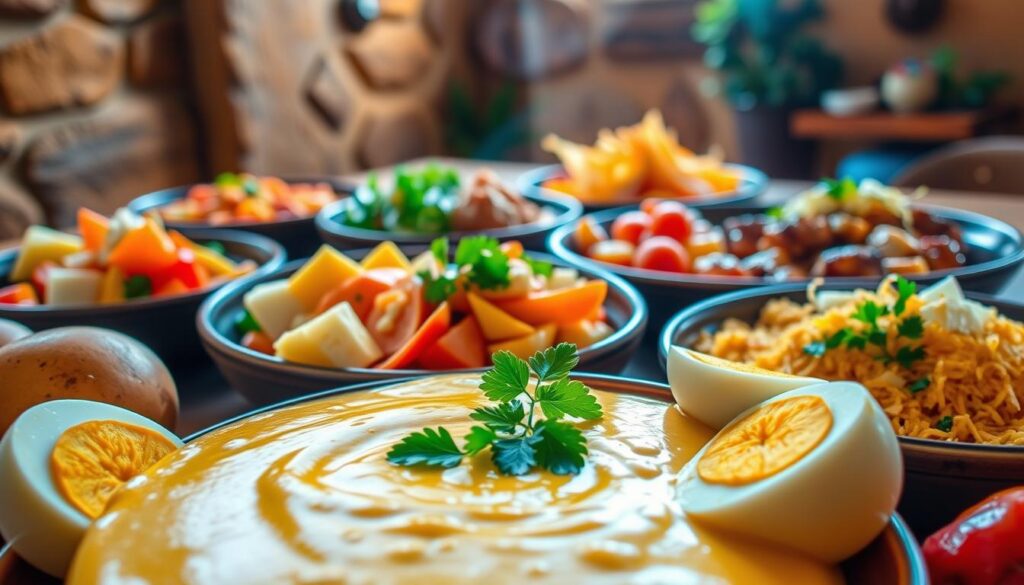
Anticuchos: Street Food at Its Best
Anticuchos hold a special place in Peruvian food culture, representing a vibrant aspect of street food life. This beloved dish primarily consists of skewered meats, most commonly made from beef heart. With roots deeply embedded in anticuchos history, these delicious morsels carry tales of indigenous cooking practices and modern culinary creativity.
The Tradition of Anticuchos
Traditionally, anticuchos are marinated in a mix of vinegar, garlic, and spices, which brings about an irresistible flavor profile. Cumin and ají are essential ingredients that elevate the dish, though variations may exist. Many street vendors serve anticuchos after sunset, turning into lively gathering spots filled with the smoky aroma of grilling meat. Locations like Doña Manuela’s stall in Lima exemplify this experience, where customers line up to savor tender and juicy beef heart skewers, often complemented by boiled potatoes and a spicy ají sauce.
Experimenting with Anticuchos at Home
To embrace this aspect of Peruvian food culture, you can try your hand at creating authentic Peruvian recipes in your kitchen. Start with classic anticuchos de corazón, or explore variations like chicken or seafood skewers. Begin by marinating your chosen meat in a blend of your favorite spices, vinegar, and garlic. Follow techniques on how to make anticuchos by threading the meat onto skewers and grilling them to achieve that smoky flavor. Enjoy these skewers as an appetizer or a main dish, alongside your homemade ají sauce for an exciting culinary journey right at home.

Pachamanca: Cooking in the Ground
Pachamanca is a fascinating aspect of Peruvian gastronomy, reflecting ancient traditions rooted in the Andean culture. This unique cooking method demonstrates respect for the earth, known as Pachamama, and illustrates a communal approach to preparing traditional Peruvian dishes. By using a natural oven dug into the ground, Pachamanca creates an authentic experience that showcases Peru’s agricultural bounty.
The Ritual of Pachamanca
The ritual of Pachamanca begins with heating volcanic stones over an open fire, placed carefully into a pit lined with earth. The process, steeped in pachamanca traditions, pays homage to ancient Incan agricultural practices and spirituality. Participants often make offerings, such as pouring chicha, a fermented corn drink, over the oven, emphasizing the cultural significance of gratitude for the land’s resources. This gathering typically takes place during festivals and celebrations, fostering social ties among the community.
Essential Ingredients for the Perfect Pachamanca
The selection of pachamanca ingredients is crucial to achieving the dish’s signature flavors. Typically, the preparation includes:
- Marinated meats such as chicken, pork, or alpaca
- Local vegetables, including potatoes, corn, and beans
- Natives herbs, particularly huacatay, which imparts an aromatic essence
The combination of these elements results in a delightful meal characterized by a blend of smoky richness from the meats and earthy sweetness from the vegetables. Still celebrated today, Pachamanca serves not only as a meal but also as a vibrant representation of Peru’s cultural heritage and agricultural connections.
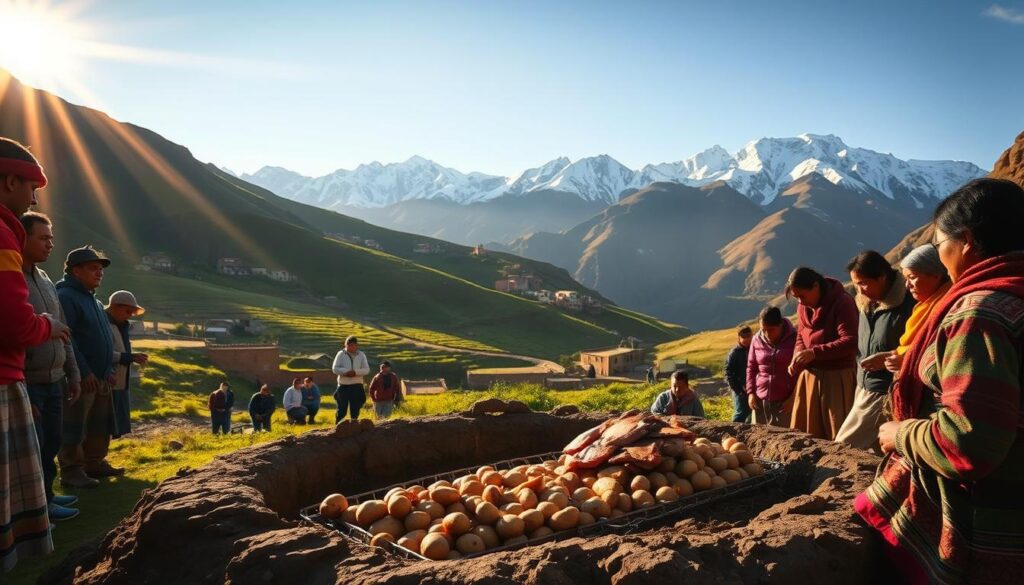
Peruvian Potatoes: A Culinary Treasure
Peru boasts over 4,000 distinct types of potatoes, making it the birthplace of this globally significant crop. With a rich heritage that dates back more than 8,000 years, these tubers play a crucial role in many authentic Peruvian recipes. Each variety offers unique flavors and textures, making them integral to popular Peruvian dishes.
Diverse Varieties of Potatoes in Peru
Peruvian potatoes are a culinary treasure found in numerous varieties, each with its own special characteristics. Some notable types include:
| Variety | Description |
|---|---|
| Papa Amarilla | Known for its buttery taste and creamy texture, popular in causa. |
| Papa Huamantanga | A unique potato with a reddish skin and yellow flesh, great for stews. |
| Papa Negra Andina | Black-skinned potato known for its delicious flavor, often used in salads. |
| Chuño | Traditional freeze-dried potato, essential in Andean dishes. |
| Papa Rosada | Pink potato with a firm texture, excellent for frying or mashing. |
Fun Ways to Cook with Peruvian Potatoes
Cooking with Peruvian potatoes opens up a world of flavors and textures. You can enjoy them in delightful ways:
- Papa a la Huancaina: Boiled potatoes topped with a creamy yellow chili sauce.
- Causa Limeña: A layered dish with yellow potatoes, lemon, and avocados.
- Carapulcra: An enduring Andean stew that incorporates dried potatoes.
- Salchipapa: A popular street food featuring French fries paired with sausage.
- Pastel de Papas: A savory pie made primarily from potatoes, cheese, and eggs.
These diverse applications of Peruvian potatoes in cooking highlight their importance and versatility in national cuisine.
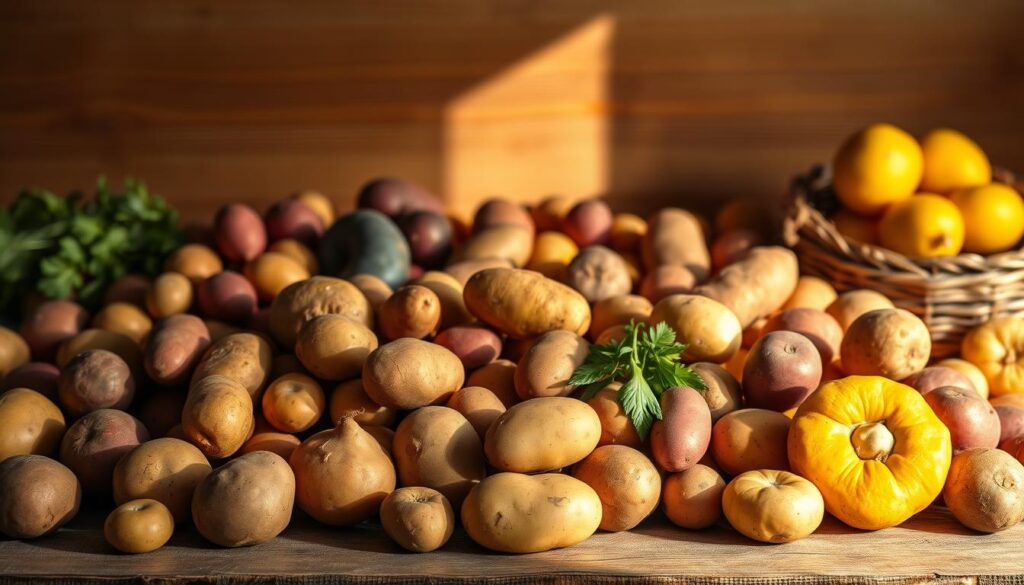
Soursop: A Unique Fruit Experience
Soursop, known in Peru as “guanábana,” is a remarkable fruit that offers a delightful blend of flavors while exemplifying elements of Peruvian food culture. Beyond its delicious taste, the nutritional value of soursop is noteworthy, contributing high levels of vitamin C and dietary fiber. This unique fruit has become a popular choice in various traditional Peruvian dishes, adding an exotic twist to the culinary scene.
Nutritional Benefits of Soursop
The nutritional value of soursop stands out, particularly for its extensive health benefits:
- High in vitamin C, supporting immune system function.
- Rich in fiber, promoting healthy digestion.
- Contains antioxidants, which help combat oxidative stress.
These benefits exemplify the health-conscious approaches often seen within Peruvian food culture, where wholesome ingredients play a vital role in daily meals.
Ways to Incorporate Soursop in Your Diet
Using soursop in your diet can elevate your meals with its distinct flavor. Here are some popular methods:
- Enjoy it fresh, either on its own or in fruit salads.
- Blend into smoothies for a refreshing drink packed with nutrients.
- Create delicious desserts like ice creams or sorbets, combining its creamy texture with sweet or tart elements.
- Use soursop juice as a flavorful addition to cocktails, enhancing drinks with a tropical twist.
- Incorporate it into savory dishes, pairing it with fish or poultry for an unconventional flavor experience.
Integrating soursop into your meals not only delights your palate but also aligns with the appreciation for vibrant and diverse ingredients seen in Peruvian cuisine.
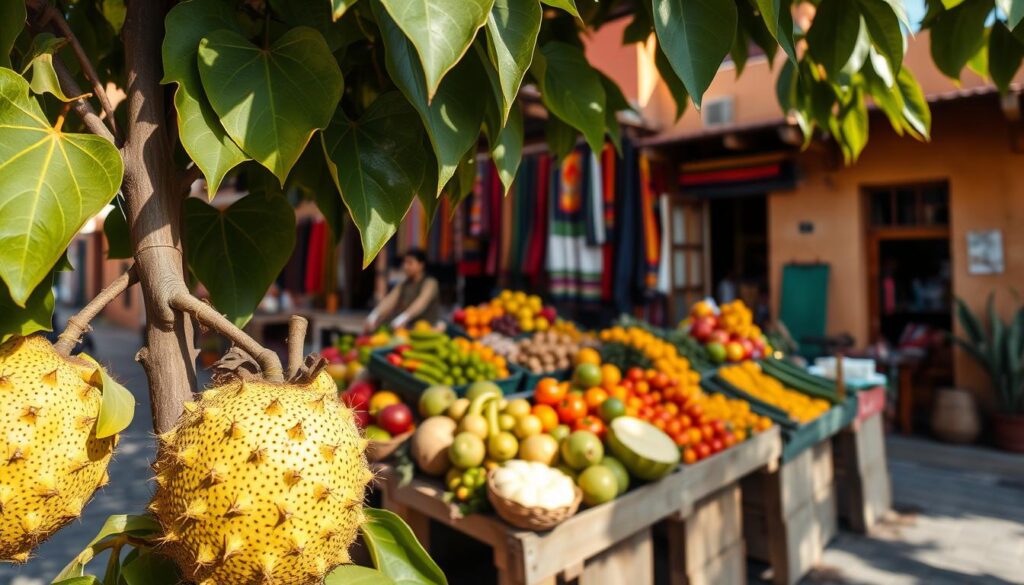
Inca Kola: The National Soft Drink
Inca Kola holds a significant place in Peruvian gastronomy, celebrated as a cultural icon for nearly 90 years. This bright yellow soft drink stands out with its distinctive Inca Kola flavor, often described as a unique mix of lemon verbena and bubblegum sweetness. Its refreshing taste makes it a delightful complement to a variety of traditional dishes, enhancing the enjoyment of your meals.
Flavor Profile of Inca Kola
What makes Inca Kola a staple in restaurants and homes alike? The answer lies in its remarkable flavor profile. This soft drink has a sweet and fruity taste, reminiscent of cream soda and bubblegum. Its unique characteristics allow it to pair beautifully with several popular dishes, making it a go-to choice for those wanting to explore Peruvian flavors. You will often find it enhancing the meals served at the best Peruvian restaurants, tying together the vibrant culinary experience.
Best Food Pairings for Inca Kola
Looking for food pairings for Inca Kola? This soft drink shines alongside grilled meats like pollo a la brasa, providing a refreshing contrast to the spices typically found in such dishes. Ceviche, with its tartness and zest, becomes even more enjoyable when accompanied by a cold glass of this iconic beverage. Fried dishes, a favorite in Peruvian cuisine, also benefit from the sweet notes of Inca Kola, creating a delightful balance of flavors.

Desserts: Sweet Endings in Peruvian Cuisine
Peruvian desserts offer a delightful exploration into the country’s rich culinary landscape. These sweets reflect a fusion of indigenous flavors and colonial influences, making them an essential part of any authentic Peruvian recipes. From alfajores filled with dulce de leche to the deep-fried picarones, Peruvian desserts are a must-try for anyone looking to indulge in something truly special.
Traditional Peruvian Desserts to Try
Among the many tempting choices, you will find some traditional Peruvian desserts that deserve your attention:
- Alfajores: Cookies filled with a luscious layer of manjar blanco, perfect for pairing with coffee.
- Picarones: Sweet potato and squash donuts, typically drizzled with rich chancaca syrup.
- Mazamorra Morada: A vibrant pudding made from purple corn, featuring warm spices like cinnamon.
- Tres Leches Cake: A moist cake soaked in three types of milk, ensuring a rich texture you won’t forget.
- Crema Volteada: The Peruvian version of flan, utilizing evaporated milk for extra creaminess.
How to Make Turrón de Doña Pepa
If you want to impress your friends and family with homemade Peruvian desserts, learning how to make traditional desserts like Turrón de Doña Pepa is a joyful endeavor. This dessert requires:
- Flour
- Butter
- Sugar
- Anise seeds
To create this treat, bake multiple layers of dough, then sandwich them with a sweet syrup made from molasses. Once assembled, top the dessert with colorful sprinkles. The Turrón de Doña Pepa recipe holds cultural significance, especially during the Feast of the Lord of Miracles, reflecting the festive spirit of Peruvian tradition.

The Influence of Japanese Cuisine: Nikkei Peruvian
Nikkei cuisine beautifully combines Japanese flavors with Peruvian culinary traditions, resulting in a unique and innovative gastronomical experience. This fusion embraces fresh seafood, traditional Peruvian ingredients, and cooking techniques from both cultures, bringing a new level of creativity to popular Peruvian dishes.
Key Elements of Nikkei Cuisine
When exploring Nikkei cuisine, you’ll discover that key elements include:
- Use of sashimi-grade fish paired with aji sauces
- Ceviche enhanced with miso for a rich flavor
- Incorporation of traditional Peruvian spices and fresh herbs
- New techniques introduced by Japanese cooks
- Fresh local ingredients that showcase Peru’s agricultural bounty
Popular Nikkei Dishes to Explore
Among the popular Nikkei dishes, you’ll find:
- Tiradito: This dish features sashimi-style fish with a slightly spicy dressing. Its name stems from the Spanish word “estiradito,” reflecting its distinct preparation.
- Sushi Rolls: Innovative sushi rolls crafted with locally sourced ingredients whereas traditional elements shine through.
- Anticuchos: Often elevated by incorporating Japanese techniques and flavors for a unique twist.
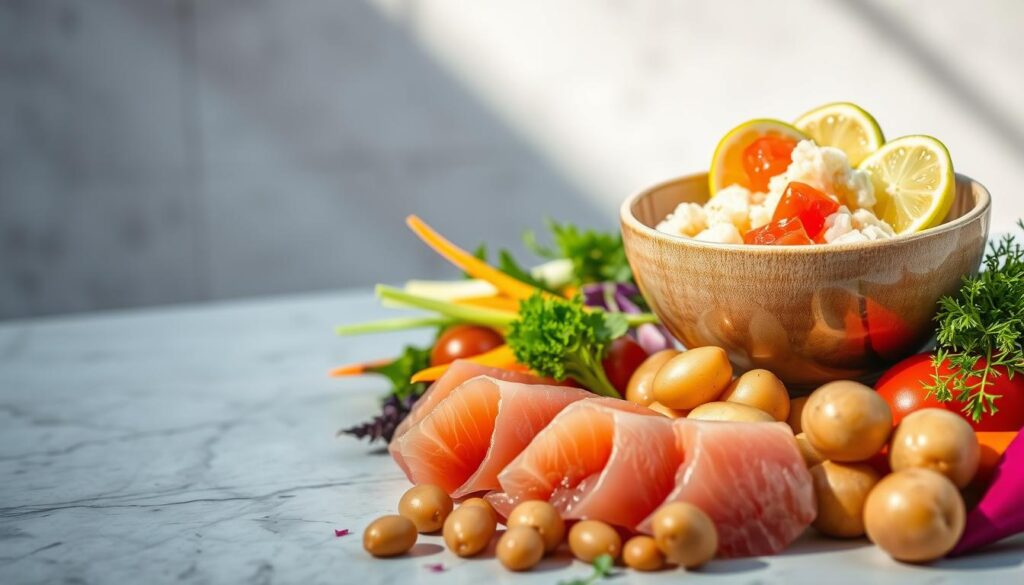
As you venture into the world of Nikkei cuisine, you’ll not only savor delightful dishes but also appreciate how this culinary fusion represents cultural connections, innovation, and a continually evolving palate. The vibrant flavors you’ll encounter make this exploration truly worthwhile.
Modern Peruvian Cuisine: A Global Trend
Modern Peruvian cuisine has gained remarkable recognition on the world stage. Influential Peruvian chefs like Gaston Acurio and Virgilio Martínez have played a crucial role in this culinary revolution, focusing on elevating traditional recipes into contemporary masterpieces. Their innovative approaches celebrate Peru’s rich culinary heritage while bringing new flavors to the forefront of global dining.
Influential Chefs in Modern Peruvian Cuisine
As champions of modern Peruvian cuisine, Gaston Acurio operates a restaurant franchise with 32 locations worldwide. His culinary vision reflects a deep appreciation for local ingredients, and he emphasizes the importance of Peru’s agricultural diversity. Virgilio Martínez, known for his acclaimed restaurant Central, merges Amazonian and Andean techniques, creating a unique dining experience that showcases the best of Peruvian gastronomy. The innovative spirit of these influential chefs has sparked a newfound interest in dining in Peru, elevating what was once considered a regional cuisine to international acclaim.
Where to Find Contemporary Peruvian Restaurants
For those eager to experience modern Peruvian cuisine, numerous spots across the globe offer creative interpretations of classic dishes. Notable establishments like Central and Maido in Lima have earned spots on the World’s 50 Best Restaurants list, each showcasing exceptional menus steeped in local authenticity. These best Peruvian restaurants are at the forefront of culinary innovation, blending traditional techniques with global influences. Dining in Peru reveals a wealth of flavors, ranging from vibrant ceviche to hearty lomo saltado, perfected by the visionaries shaping today’s culinary landscape.

Dining Etiquette in Peruvian Culture
Understanding dining etiquette in Peru is vital for anyone looking to fully appreciate the culinary experience. Dining customs in Peru highlight the communal nature of meals, often enjoyed with family and friends. These customs encompass not just the food but also the ways people interact at the table. Colorful local ceramics are commonly used for table settings, reflecting the rich cultural heritage.
Table Setting and Customs
Peruvian dining etiquette emphasizes respect and hospitality. Upon entering a home, guests should greet everyone present, which reinforces social connections. Hosts typically offer a drink, such as water or juice, right away. When it comes to the meal, it is considered impolite to refuse a substantial dish. Instead, try to communicate any dietary restrictions tactfully. Guests should strive to eat all food offered, as leaving food can be viewed negatively, indicating disinterest in the host’s efforts.
- It is customary for men and women to sit on opposite sides of the dining table.
- The meal usually starts with a toast from the host, often accompanied by phrases like buen provecho.
- In gatherings, having open discussions is encouraged, as expressed by the saying: Secretos en reunión es mala educación.
How to Show Appreciation
Showing appreciation in Peruvian culture can take various forms. Complimenting the host after enjoying the meal is essential. Small gifts, such as fruit or chocolates, can also be a thoughtful gesture, although they are not required. Importantly, avoid bringing sharp objects like knives as gifts, which can symbolize severing ties. It is customary for hosts to open gifts upon receipt to show gratitude.
By embracing these dining customs in Peru, you can genuinely engage with the culture and demonstrate respect towards the people and their traditions.
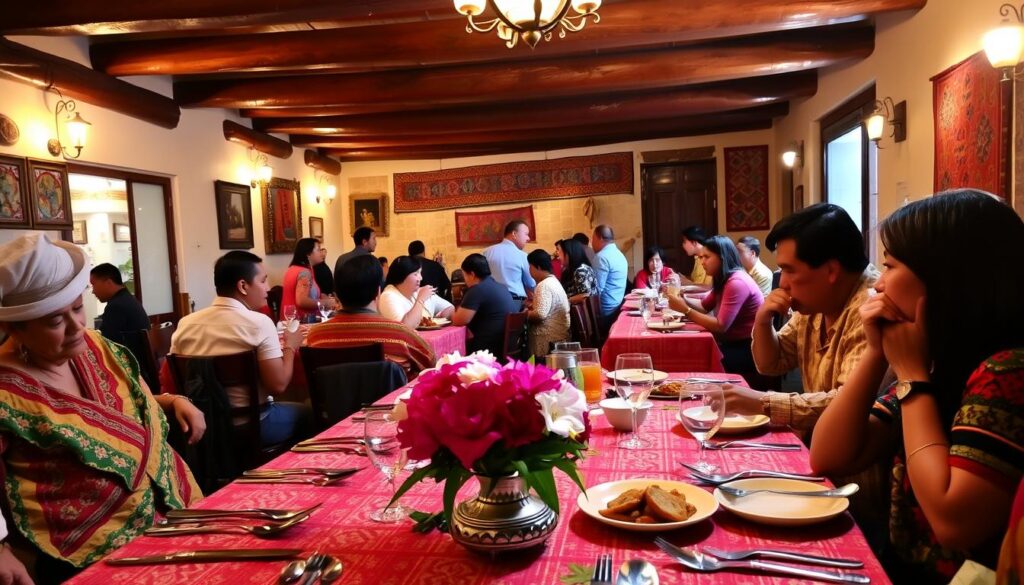
Conclusion: Why You Should Try Peruvian Cuisine
Experiencing Peruvian cuisine is more than just a meal; it’s an adventure through rich flavors, cultural significance, and time-honored traditions. With Peru recognized as possessing the best gastronomy in South America, every dish tells a unique story that’s influenced by diverse cultures, from Spanish to Japanese. Whether you’re savoring a plate of fresh ceviche or embracing the comfort of ají de gallina, you’ll find that each bite is a celebration of Peru’s culinary heritage.
Lima, the gastronomic capital, boasts nine of South America’s top restaurants, showcasing the pinnacle of what it means to experience Peruvian cuisine. Renowned chefs craft dishes using a variety of local ingredients such as over 5,000 types of potatoes, Andean superfoods like quinoa, and sustainably sourced seafood from the Pacific. This diverse ingredient palette is what makes you wonder why you should try Peruvian dishes; the options are boundless and every meal is an opportunity to explore something new.
Peruvian cuisine also shines at events like the Mistura food fair, attracting food lovers from around the world. This vibrant food culture is not only about flavors but also about community and tradition. So, whether you’re enjoying Chicha Morada with a side of street food or dining at a high-end restaurant, you’ll discover that experiencing Peruvian cuisine is indeed a feast for the senses and an unforgettable journey into the heart of Peru’s rich culinary landscape.
